Wunderpus
Wunderpus photogenicus
Many people mix up the wunderpus with the mimic octopus, but this species is a wonder of its own! The wonderpus stands out from the crowd with its distinctive candy-cane pattern, tall eye stalks, and long flat arms.
Those arms come in handy for all kinds of tricks, from probing holes in the sandy seafloor to spreading out to create a “net” to trap escaping prey!
Size
9 in long (23 cm)
Lifespan
Unknown
Habitat
Shallow seas - sand, mud, rubble
Diet
Small fishes & crabs
Range
Tropical southwestern Pacific Ocean
Predators
Unknown, probably flounder & scorpionfish
superpower
Fooling Predators
This octopus can use its red-and-white banded arms to imitate spiny lionfishes or venomous sea snakes!
SCIENTIFIC NAME: Wunderpus photogenicus
There is only one species recognized in this genus! This species is often confused with the mimic octopus (Thaumoctopus mimicus) which co-occurs in similar tropical habitats.
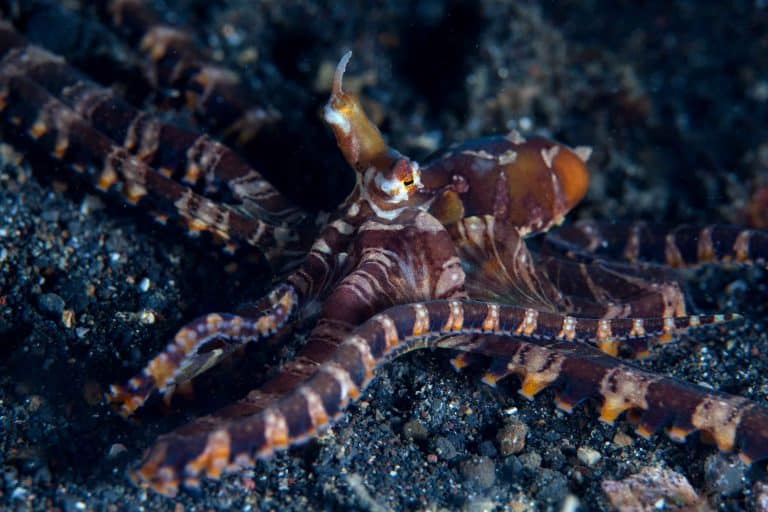
SIZE OF THE WUNDERPUS
This is a small-bodied octopus with a total length to over 230 mm and weight (wet) ~7-11 g. Its mantle length is ~24-36 mm. This species (along with other sand dwelling octopuses) has long, thin and muscular arms, the longest 5-7 times the mantle length.
WUNDERPUS LIFESPAN
Little is known of the life history and behavior of this distinctive octopus.
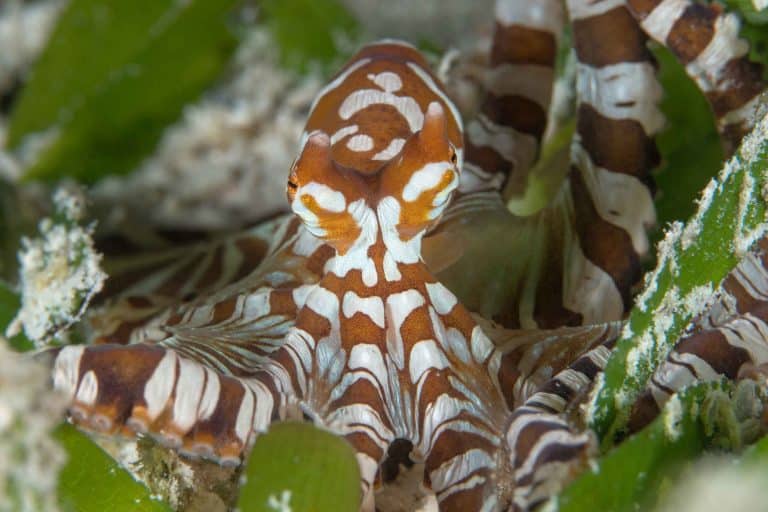
DISTRIBUTION
The distribution of the species is centered in the Indo-Malayan Archipelago and extends from Vanuatu to Papua New Guinea, Indonesia and Malaysia, north to the Philippines.
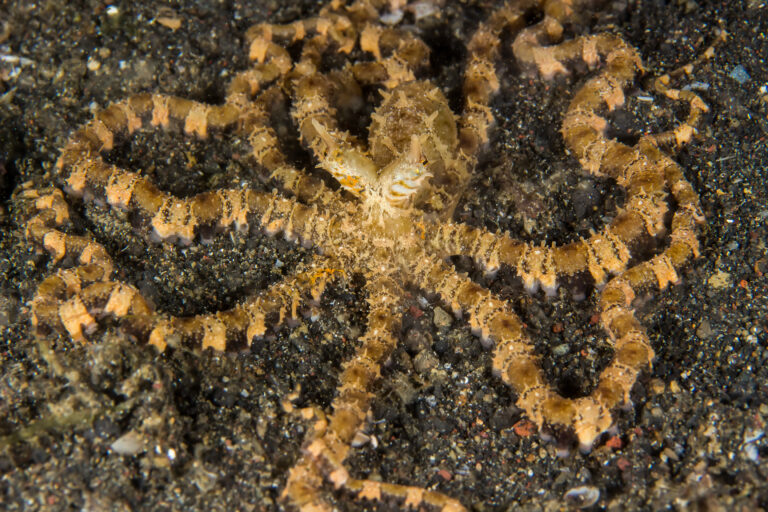
HABITAT
This species occurs on soft sediment habitats (sand, mud, and rubble substrates) in shallow waters typically less than 20 m (65 ft) deep where it occupies the burrows of other animals or may dig its own burrow. Reports from underwater photographers and data collected from specimens indicate a depth range from 0.5 to 20 m. Individuals were found to occupy the same burrow for periods of at least three weeks.
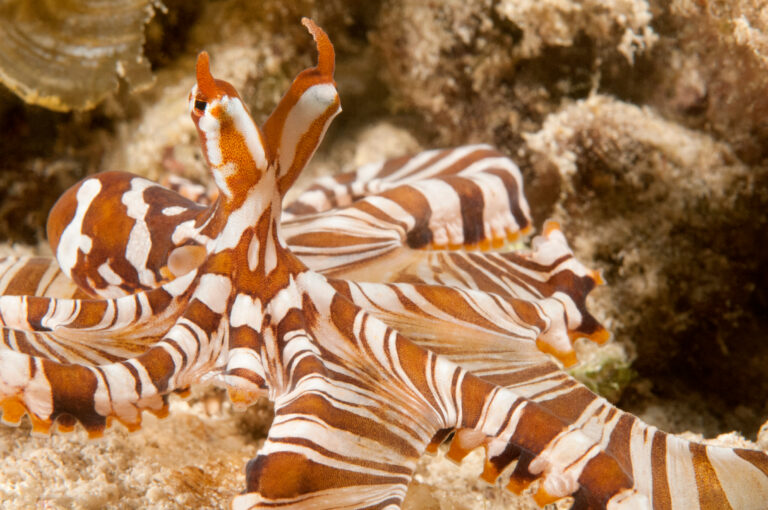
DIET
Their diet consists of small fishes and crabs (such as box crabs, Calappa spp.) that co-occur in sand, mud, and rubble substrates.
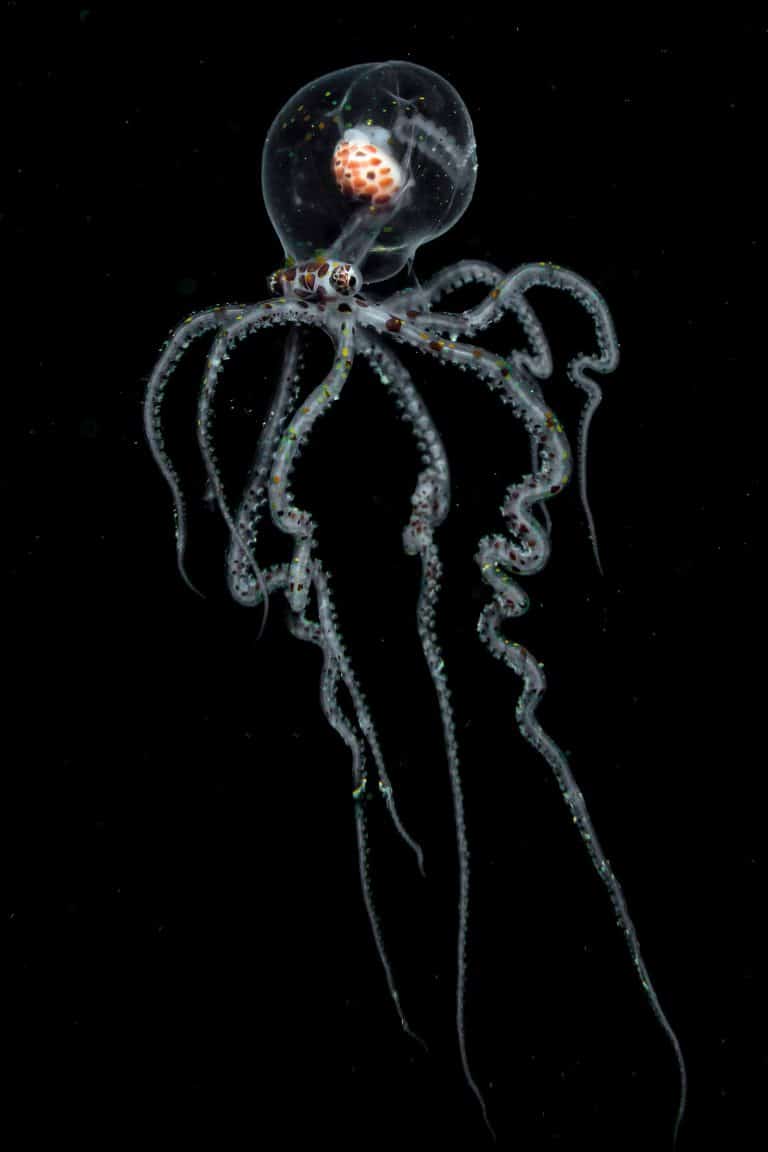
BODY PATTERNS AND BEHAVIORS
The body of Wunderpus is uniformly pale orange to red with distinct white bands along its arms and large, conspicuous white spots and bars, or stripes on its mantle, head, and eye stalks. There is a large, round white spot present on the tip of the mantle. The eyes are small and often stalked, so the head appears Y-shaped. There is a long, conical papilla over each eye (red with white tip) and thin white stripes extend from the eye down the stalk onto the mantle.
Conspicuous white bands alternate with red and extend the entire arm. The white band complex consists of a wide band plus a narrow band on either (or both) sides. Small round white spots are often visible in center of wide white arm band. The ventral mantle and arms are light in color and sucker bases are a yellow-cream color.
Wunderpus is primarily active at dusk and dawn feeding on small crustaceans and fishes by flaring its arms and webs over patches of sand or coral rubble to trap prey. This species also extends its arms into holes to probe for food. Living in open soft substrates offers little refuge from predators. Predators are unknown; however, Wunderpus is likely preyed upon by flounders and scorpionfish.
The iconic, dramatic color pattern of Wunderpus is most pronounced when the octopus is disturbed or threatened by a potential predator. This color pattern may have evolved as a defensive strategy against predators as a warning display through one of two scenarios: (1) it warns that the octopus is toxic or venomous or (2) it represents impersonations (mimicry) of toxic or venomous animals with similar color patterns which co-occur in the same habitat.
Suggested mimicry includes lionfishes (Pterois spp.) and a banded sea snake (Laticauda sp). Lionfishes possess long poisonous spines advertised with similar banded markings as seen in Wunderpus. Wunderpus has been observed to sit with six arms down a burrow while two opposite arms undulate to produce an appearance of a banded sea snake.
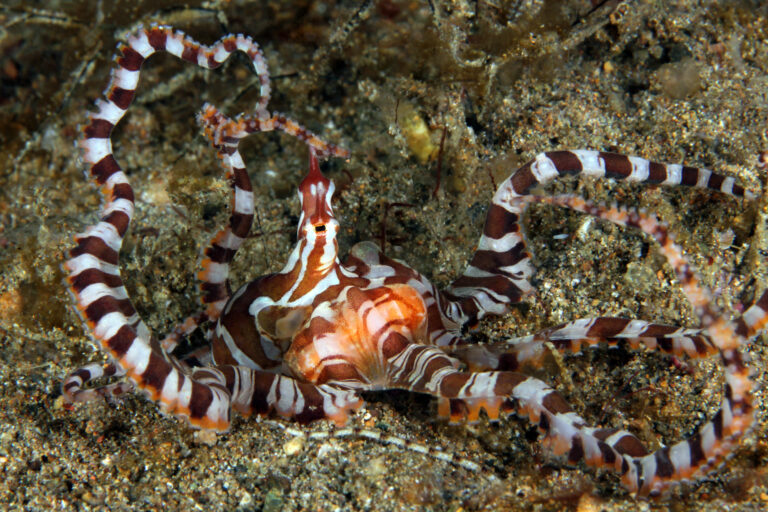
Kerstitch A (1989) Banded octopus: uncommon mimic. Sea Frontiers 35, 375.
Nielsen-Tackett, D. & Tackett, L. (2000) The Mimic Octopus, impersonation inspiration. Asian Sport Diver magazine asiandiver.com
Hocheberg FG, Norman MD, Finn J (2006). Wunderpus photogenicus n. gen. and sp., a new octopus from the shallow waters of the Indo-Malayan Archipelago (Cephalopoda: Octopodidae). Molluscan Research 26:128-140.
Norman M. (2000), Miske V and Kirchhauser J (2006), Huffard C et al. (2008b, 2009) in Jereb, P.; Roper, C.F.E.; Norman, M.D.; Julian K Finn (eds) Cephalopods of the world. An annotated and illustrated catalogue of cephalopod species known to date. Volume 3. Octopods and Vampire Squids. FAO Species Catalogue for Fishery Purposes. No. 4, Vol. 3. Rome, FAO. 2014. 370 p
Our mission is simple: We work to inspire wonder of the ocean by educating the world about octopuses.
We work with scientists, educators, and artists to make a global impact.
OctoNation® is a 501(c)(3) Nonprofit Organization